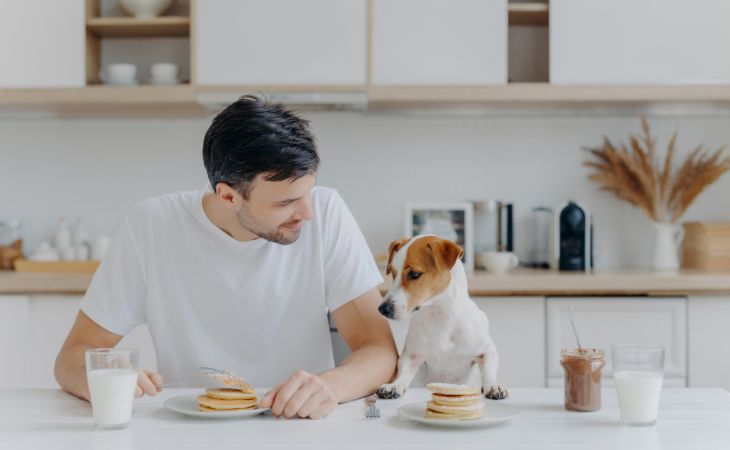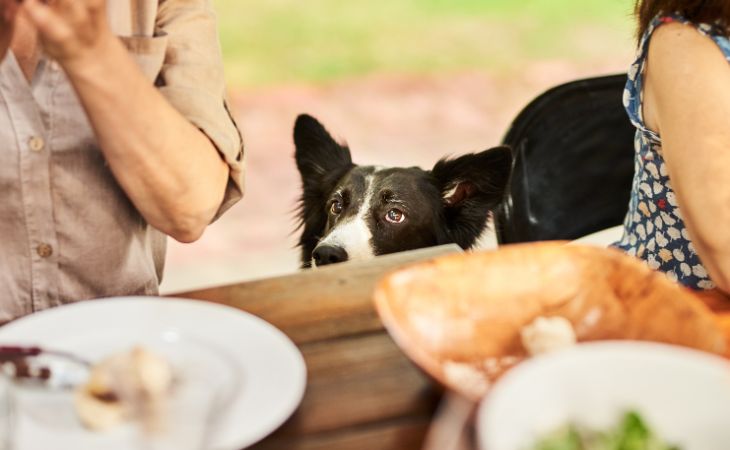It can be tempting to share your meal with your dog by giving them your table scraps. However, you need to ask yourself if these foods are suitable for your furry friend’s diet. In this article, Letsgetpet will let you know if it’s alright to give your table scraps to your dog.
Table scraps are not suited for a dog’s diet
Dogs need to eat food that is rich in proteins to maintain good health. In addition to proteins, these animals also need fats, carbohydrates, vitamins and minerals for their bodies to function properly.
Amino acids are essential for the development and reparation of their muscle tissue, and for growth and hormone regulation. Protein sources for dogs can be lean meat, poultry, fish and animal products.
In addition, fats provide concentrated energy and are important for the health of their skin and coat. While dogs are mainly carnivores, carbohydrates can be a source of additional energy. Vitamins and minerals are also essential for the immune system, growth and development, and many other bodily functions. They are found in many foods, such a meats, vegetables, and additional foods are specially made for dogs.
Your meals can contain ingredients that are not suitable for dogs. Therefore, regularly giving table scraps to your dog can lead to a nutritional imbalance. Foods consumed on a daily basis by humans are not designed to respond to the specific needs of dogs. In addition, many foods for humans can be toxic for these animals and create overfeeding.
Human food, too high in calories for dogs
Our dog can be too high in calories for dogs, which can lead to weight problems and obesity on a long term. For example, when you give a small dog a slice of sausage, which is both fat and salty, this represents the equivalent of 10 grams of kibble in terms of calories. If you give small treats like this regularly, it can quickly equal the daily calorie intake of your dog.
You need to be careful when it comes to treats and table scraps when you give them to your dog. A surplus of calories can lead to your dog gaining weight. This can contribute to health problems such as articular and cardiac problems and diabetes.
In addition to being a responsible pet owner, stick to a balanced diet specially formulated for your dog’s nutritional needs. If you wish to give your dog a small treat, choose treats that are specifically made for dogs. They are lower in calories and adapted to their diet.

Giving table scraps to your dog: it compromises their training
If you regularly give table scraps to your dog, you can risk creating behavioral problems and bad eating habits. Your dog can become may become dependent on human food, aggressive or beggarly. This can disturb your relationship with your dog and compromise their well-being.
This habit can also encourage your dog to steal food which can lead to dangerous situations. For example, they can steal a toxic or harmful food that is left on the table or counter.
When your dog is still you, you need to establish healthy eating habits. This allows you to prevent any unpleasant behavior when eating and prioritize their global health. If your dog already has this habit, you need to stay firm and not give in. You need to ignore them during meals and not give them food unless they are in their own eating area and at specific moments. This allows you to establish appropriate and healthy eating habits.
Foods that you eat regularly that are dangerous for dogs
Some foods that humans eat a lot can be toxic or dangerous for dogs. You need to know and avoid these foods when you plan to give your dog table scraps.
Chocolate
Chocolate contains theobromine, a toxic substance for dogs. It can cause symptoms such as vomiting, diarrhea, increased heart rate, and in serious cases, death. Like theobromine, caffeine is present in coffee, tea and other energy drinks. Dogs are much more sensitive to caffeine than you. Drinking a large amount can lead to heart problems, tremors, convulsions, and even death.
Grapes, raisins, and avocado
Grapes and raisins can lead to acute kidney failure in dogs, which can be potentially deadly. Symptoms can include vomiting, diarrhea, a loss of appetite, decreased urination and lethargy.
In addition, avocados contain persin, a substance that can be toxic for dogs. When your pet eats this food, they can vomit, have diarrhea, and have difficulties breathing. Eating avocados can also lead to a build-up of fluid around your dog’s heart. It also prevents his body from absorbing protein from the food he eats. As a result, your dog lacks the nutrients that are so important to his well-being.
Onions, garlic, and macadamia nuts
Containing toxic compounds, onions and garlic can damage a dog’s red blood cells and lead to anaemia. Macadamia nuts are also toxic for animals. They can cause symptoms such as vomiting, weakness, difficulties moving, and an increase in body temperature.
Due to their calcium oxalate content, raw potatoes can disrupt a dog’s urinary system. This dysfunction promotes the formation of crystals in the kidneys, urinary tract or bladder. This can lead to kidney stones.
In addition, raw potatoes contain solanine, which is also a toxin for these animals. This substance can cause nervous and digestive disorders in dogs, even death if a large amount is found in the system.
Milk and sugary foods
Some dogs are lactose intolerant, which can lead to gastrointestinal problems such as vomiting or diarrhea when they drink it. In addition, dairy products, like cheese and yogurt, are high in fats, which can lead to pancreatitis in animals.
Sugary foods and artificial sweeteners like xylitol (present in some chewing gums, candy, bakery items) can be toxic for dogs. They can cause excessive insulin release. This can lead to a dangerous drop in blood sugar levels, convulsions, liver damage and death.
If your dog ingests a dangerous food, the ideal option is to bring your dog to the vet as quickly as possible. Only a professional can respond to your questions and take care of your dog.

